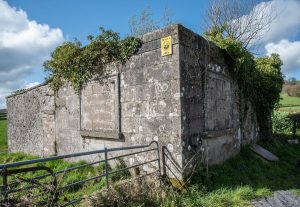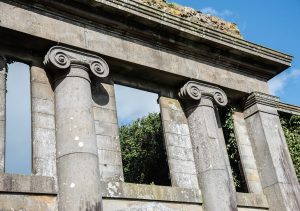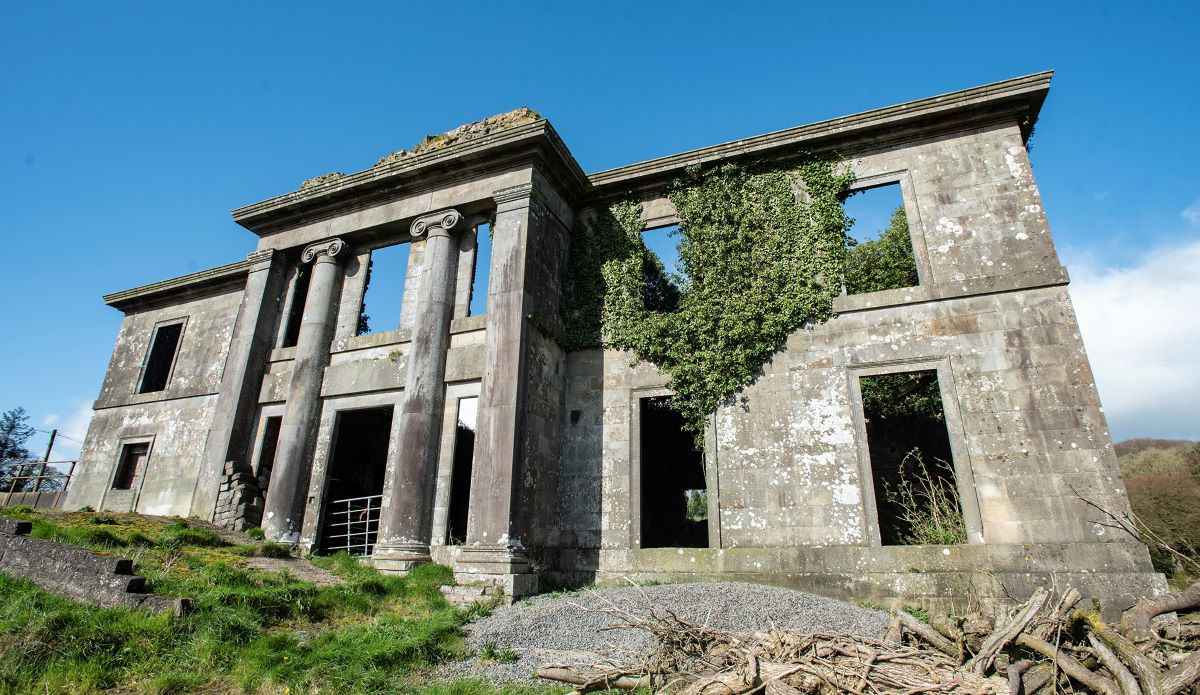Along the Omagh Road towards Ballygawley stands the distinctive ruins of a once-grand estate that met its demise in a mysterious arson attack.

Many believe that the IRA was responsible for destroying the 200-year-old Stewart’s House back in 1922, but other theories point towards an insurance scam.
Also referred to as Greenhill or Ballygawley House, the property was first built in the 1820s by a baronet named Sir Hugh Stewart, who was also an MP for Tyrone.
The Stewarts, originally from Scotland, first arrived in Tyrone around 1627, when Captain Andrew Stewart ventured south to defend settlements during the nine-year war.
Captain Stewart aided the defence of forts at Dungannon and Mountjoy, and he further served to quash an uprising at Artclea, outside Fivemiletown.
However, by 1650, he was captured and put to death by rebels following Sir Phelim O’Neill’s insurrection.

In the years afterwards, his descendants took residence in townlands surrounding
Ballygawley, with his grandson, The RT Hons John Stewart, moving to Athenree.
John Stewart was well-established in local politics, having served as a barrister, and he ascended the ranks of law and to become Attorney General for Ireland in 1799.
Alongside his work at the bar, John was elected as a MP for
Augher, and by 1803, he was made a baronet.
He was succeeded by his son, Hugh, who took on his baronet and settled down in Ballygawley, building his new house on a hill amongst the green fields outside the town.
Sir Hugh sought the esteemed architect, John Hargraves, from Cork, who, by this stage, had a fine reputation in the Tyrone area for his works, one of which was the Omagh Courthouse.
The newly-built manor was situated in its own parkland, and boasted a classic architectural style, complete with Doric columns and a grand portico that adorned its two-story facade.
Below the hill, tall gates heralded the entrance to the manor, joined by a house occupied by the gatekeeper.
Yet, for all of its grandness, the property was occupied for less than 100 years.
While living there, Sir Hugh served as a Tory MP for the county, and was later appointed to High Sheriff in 1827.
The family’s influence on local politics continued as the baronet was passed to Sir Hugh’s eldest son, John Marcus, who became the deputy Lord Lieutenant and High Sheriff of Tyrone by 1858.
John’s son, Hugh Houghton Stewart, was the last of the Stewarts to occupy the house.
He grew up in the grand Ballygawley estate, and followed in the footsteps of his forefathers, enlisting in the army as an officer after his training at the Royal Military College in Sandhurst.
Hugh served with the Royal Inniskilling Fusiliers and Royal Irish Rifles in the Boer war, later serving in WWI between 1914 and 1916.
Upon his return to Ireland, he took on several roles in local government, including the Justice of Peace, the High Sheriff and Deputy Lord Lieutenant.
Hugh also decided to depart the manor and moved to Loughmacrory Lodge in Carrickmore, leaving the magnificent house up for grabs.
In 1918, the property fell into the hands of Hugh McLaurin, a Justice of the Peace from Belfast.
It was during his ownership that the grand estate itself would meet its demise.
Despite acquiring the house, McLaurin never took up residence, leaving it vacant.
This abandonment left the property vulnerable to attack, and in 1922, a vicious blaze destroyed the house beyond repair.
A report in the UH on April 15, 1922, stated that two
months earlier, on February 17 around 3am, a local farmer became alarmed after seeing the estate engulfed in fire.
He gathered a group of neighbours and they went to the house, where they observed the bottom floor windows and a side door to the property wide open.
Upon inspection, they found numerous empty petrol cans alongside bales of hay.
The men attempted to extinguish the fire, but their attempts were mostly futile, saving only a section of the roof.
In court, when Hugh McLaurin was claiming for damages, the
farmer alleged that he heard the B Specials were going to buy the property.
At the end of the hearing, McLaurin was awarded £20,000 in damages, despite an evaluation of damages by a rural council member amounting to more than £6,000.
Many believe that the IRA carried out the arson attack during its campaign of destroying various country manors across Ireland, however others speculate that it was destroyed in an insurance scam.
Since its destruction over 100 years ago, the remaining façade has laid bare, but the distinctive frontage is still highly visible from the A5 road.
The remains of the property are now a storage area for local farmers – a stark contrast to its former splendour.







